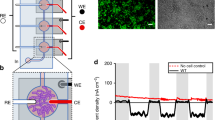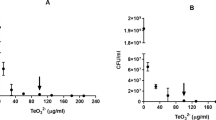Abstract
The facultative phototroph Rhodobacter capsulatus takes up the highly toxic oxyanion tellurite when grown under both photosynthetic and respiratory growth conditions. Previous works on Escherichia coli and R. capsulatus suggested that tellurite uptake occurred through a phosphate transporter. Here we present evidences indicating that tellurite enters R. capsulatus cells via a monocarboxylate transport system. Indeed, intracellular accumulation of tellurite was inhibited by the addition of monocarboxylates such as pyruvate, lactate and acetate, but not by dicarboxylates like malate or succinate. Acetate was the strongest tellurite uptake antagonist and this effect was concentration dependent, being already evident at 1 μM acetate. Conversely, tellurite at 100 μM was able to restrict the acetate entry into the cells. Both tellurite and acetate uptakes were energy dependent processes, since they were abolished by the protonophore FCCP and by the respiratory electron transport inhibitor KCN. Interestingly, cells grown on acetate, lactate or pyruvate showed a high level resistance to tellurite, whereas cells grown on malate or succinate proved to be very sensitive to the oxyanion. Taking these data together, we propose that: (a) tellurite enters R. capsulatus cells via an as yet uncharacterized monocarboxylate(s) transporter, (b) competition between acetate and tellurite results in a much higher level of tolerance against the oxyanion and (c) the toxic action of tellurite at the cytosolic level is significantly restricted by preventing tellurite uptake.

Similar content being viewed by others
Abbreviations
- ROS:
-
Reactive oxygen species
- DDTC:
-
Diethyldithiocarbamate
- NEM:
-
N-ethylmaleimide
- FCCP:
-
Carbonyl cyanide-p-trifluoromethoxyphenyl-hydrazone
References
Avazéri C, Turner RJ, Pommier J, Weiner JH, Giordano G, Verméglio A (1997) Tellurite reductase activity of nitrate reductase is responsible for the basal resistance of Escherichia coli to tellurite. Microbiology 143:1181–1189
Borghese R, Borsetti F, Foladori P, Ziglio G, Zannoni D (2004) Effects of the metalloid oxyanion tellurite (TeO 2−3 ) on growth characteristics of the phototrophic bacterium Rhodobacter capsulatus. Appl Environ Microbiol 70:6595–6602
Borsetti F, Borghese R, Francia F, Randi MR, Fedi S, Zannoni D (2003a) Reduction of potassium telurite to elemental tellurium and its effect on the plasma membrane redox components of the facultative phototroph Rhodobacter capsulatus. Protoplasma 221:153–161
Borsetti F, Toninello A, Zannoni D (2003b) Tellurite uptake by cells of the facultative phototroph Rhodobacter capsulatus is a ΔpH-dependent process. FEBS Lett 554:315–318
Borsetti F, Tremaroli V, Michelacci F, Borghese R, Winterstein C, Daldal F, Zannoni D (2005) Tellurite effects on Rhodobacter capsulatus cell viability and superoxide dismutase activity under oxidative stress conditions. Res Microbiol 156:807–813
Cadenas E (1989) Biochemistry of oxygen toxicity. Annu Rev Biochem 58:79–110
Chiong M, González E, Barra R, Vásquez C (1988) Purification and biochemical characterization of tellurite-reducing activities from Thermus thermophilus HB8. J Bacteriol 170:3269–3273
Di Tomaso G, Fedi S, Carnevali M, Manegatti M, Taddei C, Zannoni D (2002) The membrane-bound respiratory chain of Pseudomonas pseudoalcaligenes KF707 cells grown in the presence or absence of potassium tellurite. Microbiology 148:1699–1708
Fridovich L (1995) Superoxide radical and superoxide dismutases. Annu Rev Biochem 64:97–112
Hosie AHF, Allaway D, Poole PS (2002) A monocarboxylate permease of Rhizobium leguminosarum is the first member of a new subfamily of transporters. J Bacteriol 184:5436–5448
Imlay JA, Linn S (1988) DNA damage and oxygen radical toxicity. Science 240:1302–1309
Ingham CJ, Armitage JP (1987) Involvement of transport in Rhodobacter sphaeroides chemotaxis. J Bacteriol 169:5801–5807
Kessi J, Ramuz M, Wehrli E, Spycher M, Bachofen R (1999) Reduction of selenite and detoxification of elemental selenium by the phototrophic bacterium Rhodospirillum rubrum. Appl Environ Microbiol 65:4734–4740
Lloyd JR, Mabbett AN, Williams DR, Macaskie LE (2001) Metal reduction by sulphate-reducing bacteria: physiological diversity and metal specificity. Hydrometallurgy 59:327–337
Lowry OH, Rosebrough NJ, Farr AL, Randall RJ (1951) Protein measurement with the Folin phenol reagent. J Biol Chem 193:265–275
Moore MD, Kaplan S (1992) Identification of intrinsic high-level resistance to rare-earth oxides and oxyanions in members of the class Proteobacteria: characterization of tellurite, selenite, and rhodium sesquioxide reduction in Rhodobacter sphaeroides. J Bacteriol 174:1505–1514
Moore MD, Kaplan S (1994) Members of the family Rhodospirillaceae reduce heavy metal oxyanions to maintain redox poise during photosynthetic growth: these metal-reducing bacteria may help to remediate environmental pollution. ASM News 60:17–23
O’Gara JP, Gomelsky M, Kaplan S (1997) Identification and molecular genetic analysis of multiple loci contributing to high-level tellurite resistance in Rhodobacter sphaeroides 2.4.1. Appl Environ Microbiol 63:4713–4720
Pearion CT, Jablonski PE (1999) High level, intrinsic resistance of Natronococcus occultus to potassium tellurite. FEMS Microbiol Lett 174:19–23
Rojas DM, Vásquez CC (2005) Sensitivity to potassium tellurite of Escherichia coli cells deficient in CSD, CsdB and IscS cysteine desulfurases. Res Microbiol 156:465–471
Summers AO, Jacoby GA (1977) Plasmid-determined resistance to tellurium compounds. J Bacteriol 128:276–281
Tantaleán JC, Araya MA, Saavedra CP, Fuentes DE, Pérez JM, Calderón IL, Youderian P, Vásquez CC (2003) The Geobacillus stearothermophilus V iscS gene, encoding cysteine desulfurase, confers resistance to potassium tellurite in Escherichia coli K-12. J Bacteriol 185:5831–5837
Taylor DE (1999) Bacterial tellurite resistance. Trends Microbiol 7:111–115
Tomás JM, Kay WW (1986) Tellurite susceptibility and non-plasmid-mediated resistance in Escherichia coli. Antimicrob Agents Chemother 30:127–131
Turner RJ (2001) Tellurite toxicity and resistance in Gram-negative bacteria. Rec Res Dev Microbiol 5:69–77
Turner RJ, Weiner JH, Taylor DE (1992) Use of diethyldithiocarbamate for quantitative determination of tellurite uptake by bacteria. Anal Biochem 204:292–295
Turner RJ, Weiner JH, Taylor DE (1995) The tellurite-resistance determinants tehAtehB and klaAklaBtelB have different biochemical requirements. Microbiology 141:3133–3140
Turner RJ, Weiner JH, Taylor DE (1999) Tellurite-mediated thiol oxidation in Escherichia coli. Microbiology 145:2549–2557
Vásquez CC, Saavedra CP, Loyola CA, Araya MA, Pichuantes S (2001) The product of the cysK gene of Bacillus stearothermophilus V mediates potassium tellurite resistance in Escherichia coli. Curr Microbiol 43:418–423
Walter EG, Taylor DE (1992) Plasmid-mediated resistance to tellurite: expressed and cryptic. Plasmid 27:52–64
Weaver PF, Wall JD, Gest H (1975) Characterization of Rhodopseudomonas capsulata. Arch Microbiol 105:207–216
Willison JC (1988) Pyruvate and acetate metabolism in the photosynthetic bacterium Rhodobacter capsulatus. J Gen Microbiol 134:2429–2439
Yurkov V, Jappé J, Verméglio A (1996) Tellurite resistance and reduction by obligately aerobic photosynthetic bacteria. Appl Environ Microbiol 62:4195–4198
Acknowledgments
We thank the Ministero Istruzione Università e Ricerca (MIUR) for supporting this work (Grant: PRIN 2005–2006). D.M. is a recipient of a PhD fellowship from the University of Bologna (PhD School of Biological Sciences, Biomedicine and Biotechnology; XXI program: 2006–2008).
Author information
Authors and Affiliations
Corresponding author
Additional information
Communicated by Jörg Overmann.
Rights and permissions
About this article
Cite this article
Borghese, R., Marchetti, D. & Zannoni, D. The highly toxic oxyanion tellurite (TeO 2−3 ) enters the phototrophic bacterium Rhodobacter capsulatus via an as yet uncharacterized monocarboxylate transport system. Arch Microbiol 189, 93–100 (2008). https://doi.org/10.1007/s00203-007-0297-7
Received:
Revised:
Accepted:
Published:
Issue Date:
DOI: https://doi.org/10.1007/s00203-007-0297-7




